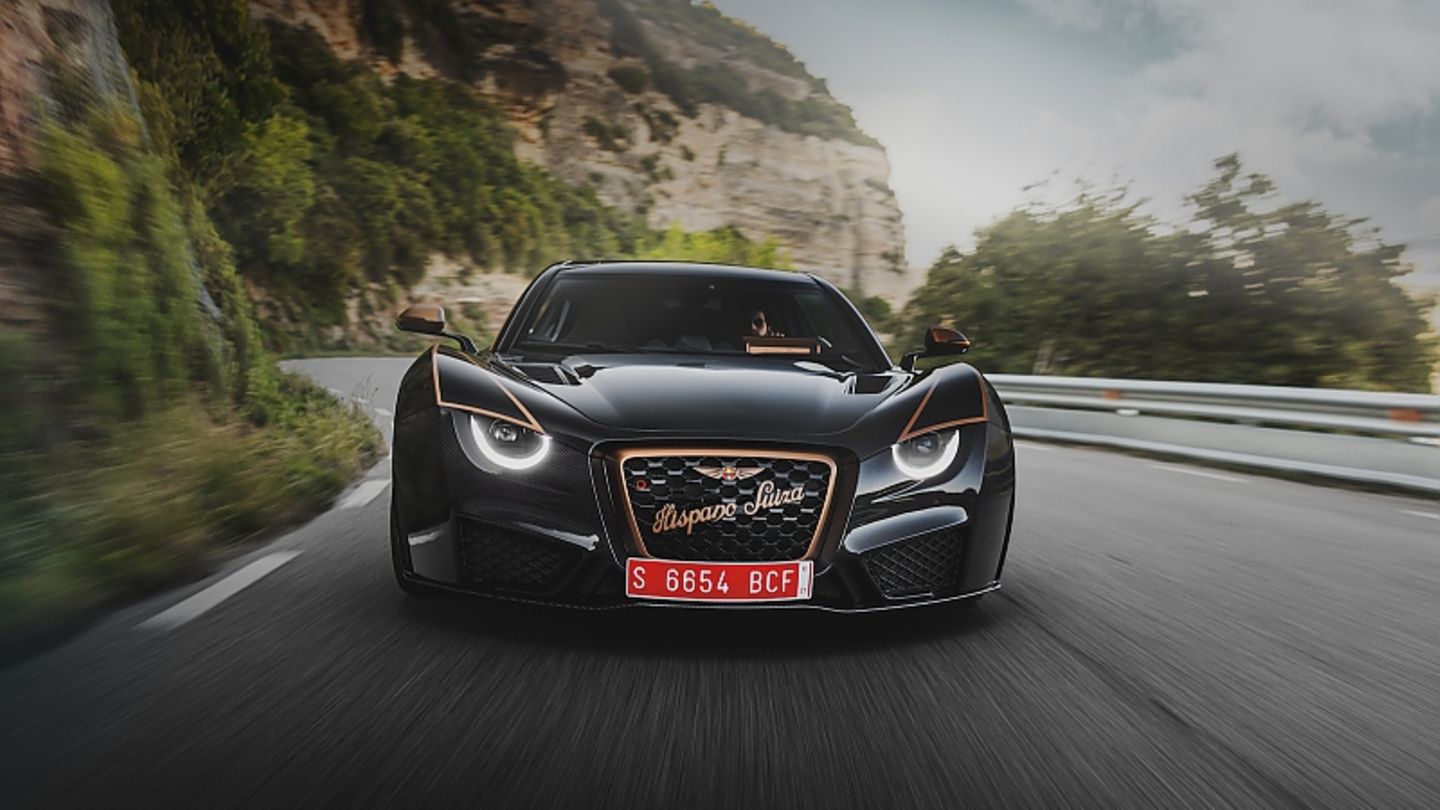Really romantic stories – where else can these be found in the sober business world? The car industry makes no difference – much to the displeasure of many fans. The revitalized Hispano Suiza brand with its enchanting Carmen – over 1,000 hp strong – shows that there is another way.
The story of the softly drawn Carmen – an electric car, of course – began with a promise that the company’s president once made to his mother as the founder’s granddaughter. Now this promise has become reality – with the Hispano Suiza Carmen Boulogne, a spectacular electric racer for more than 1.6 million euros. That’s what happens when you combine a Formula E monocoque with a female body that was bathed in the genes of a historic car brand. Hispano Suiza has had a reputation like Donnerhall in the world of classic automobiles since the 1920s, but modern reality has been a long – very long time. Over the decades, investors, engineers and dreamers tried again and again to wrench the traditional manufacturer – once the most exclusive car brand of its kind – out of its slumber. Without success.
But now the first modern Hispano-Suiza vehicle is being delivered to a multi-million dollar American collector in Miami, which is to be followed by another 23 of the 24 planned examples. All specimens are assembled by a skilled hand near Barcelona after a highly individual order. Since the presentation of the first concept vehicle at the Geneva Motor Show two and a half years ago, the special exterior design has divided public opinion: many see it as a mixture of a modern Bugatti and the classic Hispano Suiza H6C Dubonnet Xenia; other than denigrating history. The original model – presented at the Paris Motor Show in 1932 as the fastest car of its time – reached a top speed of 160 km / h shortly before the Second World War. The one-off piece was manufactured at the special request of the pilot André Dubonnet and was intended to combine the features of an automobile with those of a contemporary aircraft fuselage. The car had an independent wheel suspension, invented by the racing driver and designer, in which the leaf springs were replaced by coil springs.
The 2019 concept retained clear influences from this historic model and ultimately got scissor doors, as we know them from Lamborghini or McLaren models. “These are not bad references. But in reality we are following our evolutionary DNA to create an electric sports car with strong character and aerodynamic efficiency,” explains Francesc Arenas, Design Director at Hispano Suiza. The body of the two-seater is made of carbon fiber, as is the monocoque, which weighs just 195 kilograms. The rear subframe, the seat structure and the door panels are also given maximum rigidity with a correspondingly light weight thanks to carbon fibers. The suspension with double wishbones at the front and rear is heavily inspired by the suspension of the Monoposti and also contributes to the fact that the car only weighs 1,630 kilograms, which means a power-to-weight ratio of 1.46 kg / hp with a spectacular 1,114 hp. This gigantic power is generated by two permanent magnet synchronous motors, which are each attached to the rear wheels. They ensure a top speed of 290 km / h and an image spurt from 0 to 100 km / h in less than 2.6 seconds. Corresponding deceleration values guarantee carbon-ceramic brakes and high-speed tires.
In some ways this Hispano Suiza is a Formula E racing car with a body and a two-seater interior. “This is how you can really get to the heart of Carmen,” says test driver Luis Perez-Sala with a big smile before heading into the cockpit of the Hispano Suiza Carmen to do a few quick laps on the Montmeló race track. Right next door is the Hispano Suiza assembly plant on the outskirts of Barcelona. “It takes seven to nine months to assemble any handcrafted car, even with the help of 3D printing, which makes 60 parts,” said Joan Orus, Hispano’s chief technical officer. The official range of 400 kilometers on one charge is supposed to enable the 80 kWh lithium-ion battery in the underbody. Thanks to the 100 kW charge, the battery pack increases to up to 80 percent of its potential in half an hour, while the 22 kW charger takes six hours to refuel.
But now it finally starts. A push of a button and the doors of the elegant Carmen open electrically, so that I can take a seat behind the separated lower part of the steering wheel. Everything is coated with Alcantara, carbon fiber and rose gold aluminum and so it fits perfectly with the interior – it is also comfortable. With the paddles, the driver can vary the energy recovery in six stages, but a maximum of 50 kWh is not much in maximum mode. The central infotainment display is arranged vertically and, like the digital instrument panel, has been wrapped in a retro design. The driver now has to choose one of the three driving modes that offer the corresponding access to different performance values: Eco (340 PS / 600 Nm), Comfort (476 PS / 800 Nm) and Sport (680 PS / 1050 Nm). In the latter program, the launch function can also be activated to activate a boost for 30 seconds, which increases the performance to up to 1,114 hp and 1,150 Nm. Carmen dispenses with variable damping, but offers different suspension settings through variable compression and rebound levels on each shock absorber as well as camber and caster angles. You know that very well from racing.
The race track starts with a lot of thrust, but already in the first sequence of turns you can see that the brake pedal is not working as it should: The first third of the pedal travel does nothing more than tickle the brake discs, whereby the speed is barely noticeable is reduced. From the middle of the pedal travel you can feel the braking force and the Hispano only really goes into action when you pedal hard. “We have to increase the initial pressure, of course,” admits Joan Orus as CTO, “the Carmen Boulogne is not a car to set new course records, but to experience very special moments behind the wheel.”
The steering, on the other hand, feels too smooth and even in sport mode the feedback is not really sporty, but rather artificial. The drive package for the up to 1,114 hp electric motors in the rear is completely different. In the short intermediate sprint, the almost 1.7 ton electric car shoots off as you would like it to be in the 1,000 hp league – the facial features literally derail. It is time to become more courageous and push the Spaniard to the limit in order to feel him, feel him, breathe in – Carmen, I’m coming. Are you kidding me? Are you serious when you say that. With a short throttle in a tight curve, the tail wedges wildly and Carmen does a wild 360-degree pirouette – counter-steering pointless – too slow and the coordination for eyes, arms and legs does not make the whole thing easier with this performance. But so wild? The traction control was deactivated and no one even said a puck. I recover from the shock and the color returns to my face while the joy quickly outweighs the fact that the 1.65 million euro racer stayed on the slopes. The first customer can hardly wait and the next 23 scratch their tires. But it shouldn’t stop at the 1,114 hp and 1,1 150 kilograms. 1,500 hp and all-wheel drive are planned – for Carmen II. Rimac and Pininfarina send their regards. But even the 1.65 million euros will hardly be enough.
Source From: Stern
I am a 24-year-old writer and journalist who has been working in the news industry for the past two years. I write primarily about market news, so if you’re looking for insights into what’s going on in the stock market or economic indicators, you’ve come to the right place. I also dabble in writing articles on lifestyle trends and pop culture news.




